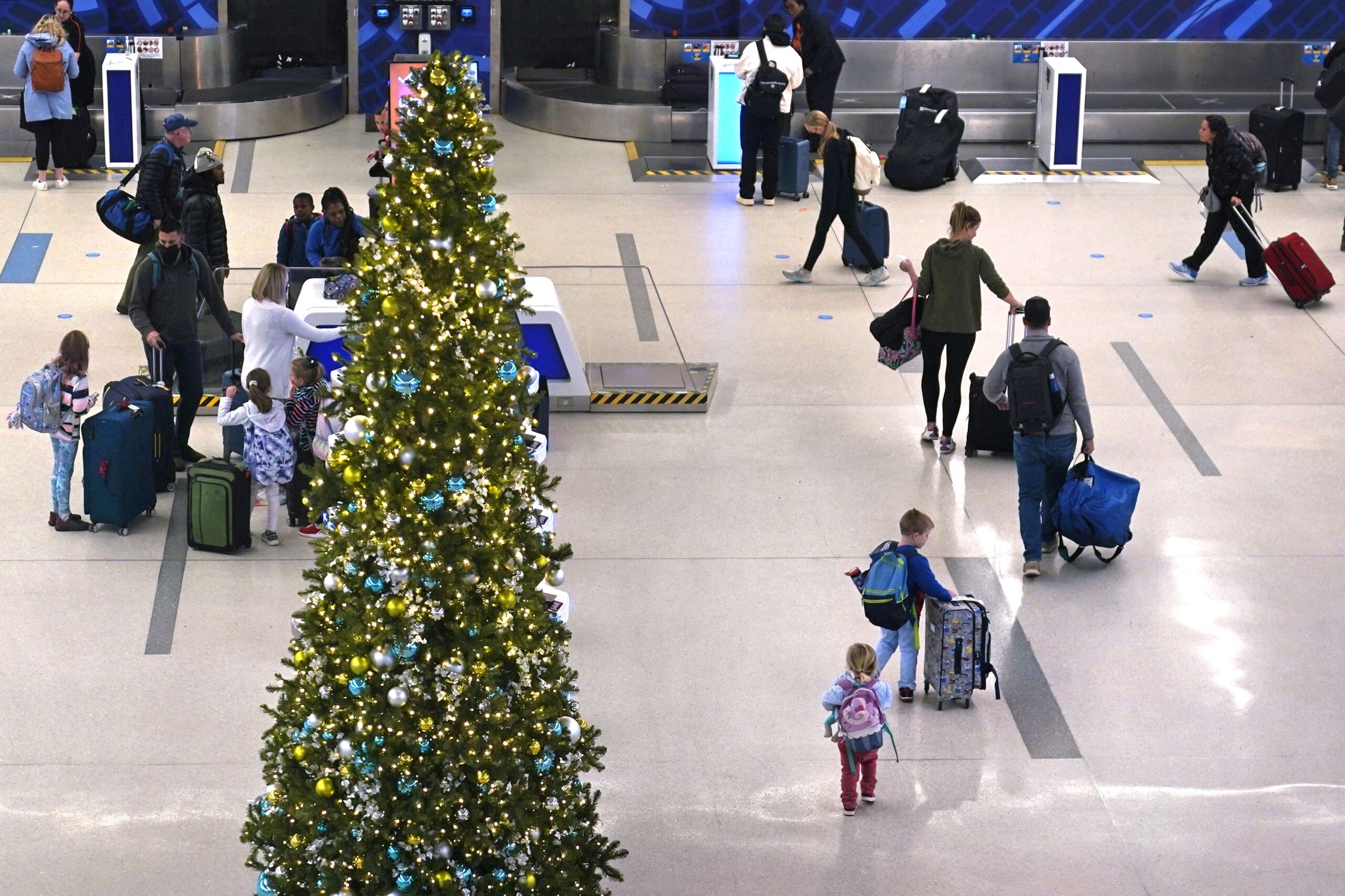Remote and hybrid work has reshaped the typical seasonal rush. Airlines and hotels see dollar signs.
THERE WAS SOMETHING curious about the US Transportation Security Administration’s data on passenger traffic at airports last month. The Sunday after Thanksgiving was, as usual, very busy, with 2.6 million people screened at security checkpoints. That’s the most on any single day since the pandemic began, and evidence that many people are back to traveling again. But other historical patterns didn’t hold. The Friday before Turkey Day, almost a week ahead of the holiday, was busier than the equivalent day in 2019 and almost as busy as the day before the holiday—traditionally the peak travel day of the year. People are traveling again, but not in the ways they used to.
Airlines had predicted that Thanksgiving travel would be weird. Between pent-up travel demand, sky-high ticket prices, and flexible work-from-home schedules, some people chose to fly at different times than in previous years. And carriers are forecasting similar pattern-breaking travel during the December holidays, stretching from now through Hanukkah, Christmas, and Kwanzaa, and past New Year’s Day. “The bookings are a little bit different this year,” Andrew Nocella, United Airlines’ executive vice president and chief commercial officer, said in October during a call with investors. “They’re more spread out across multiple days than they were in the past.”
In other words, the great holiday rush has become the great holiday mush, more a blob of intensified travel than a burst of large spikes. A survey conducted by consultants Deloitte found that American travelers are adding an average of six days to their seasonal trips this year because of flexible work arrangements. With remote work seemingly here to stay, the way some people travel during the holidays has perhaps changed forever. They can now skip the most hectic and fraught days of the travel season—and perhaps save a little money doing so.
A holiday scramble that is more dispersed, with lower peaks, is also Christmas music to airlines’ ears. “We can become much more efficient because demand is regularly high at all periods,” Robert Isom, the CEO of American Airlines, said at an event hosted by the travel news site Skift in November. That means airlines and hotels, still short of pilots and cleaners and attendants, may not need to turn over planes and rooms as quickly as during a traditional holiday crunch. And less intense competition between passengers for seats or rooms on specific days might mean companies can take more bookings overall. “This is going to help us operationally,” Ed Bastian, the CEO of United Airlines, said as he explained the phenomenon to investors this fall.
Less happily, the changes could mean fewer breaks for travel workers. “It makes the holidays a bit harder,” Sara Nelson, the president of 50,000-member labor union the Association of Flight Attendants-CWA, said in a statement. “We used to plan our own holidays and work schedules around typical travel patterns. Now, flights are full all the time. This makes it hard to get to work or utilize the benefits that come with our jobs.”
Why is the holiday travel blob manifesting now? It’s the collision of three trends in the way people are traveling and working in the wake of pandemic-era lockdowns and restrictions.
One is the growth in remote or hybrid work. Fourteen percent of US full-time employees are fully remote, according to a recent survey, and 29 percent work outside the office a few days a week. Two, many people have a pandemic hangover that expresses itself not through an urge to lie down, as most hangovers do, but in a desire to get out, whether to visit Mom or see the world. And three, supply constraints—in airplane seats on flights still operating curtailed schedules, car rentals, and hotel rooms—are driving up prices and pushing some people to consider traveling on non-peak days. “If people find a better deal to travel on a Monday or a Tuesday or a Wednesday and they have the flexibility to do that, they will,” says Vik Krishnan, a partner with McKinsey who consults clients in the aviation, travel, and aerospace industries.
FEATURED VIDEOAirline Pilot Breaks Down Flying Scenes From Film & TV
MOST POPULAR
- SCIENCEEveryone Is Sick Right NowAMANDA HOOVER
- IDEAS ‘Magic Avatar’ App Lensa Generated Nudes From My Childhood PhotosOLIVIA SNOW
- SECURITYWhat You Should Know Before Using the Lensa AI AppREECE ROGERS
- GEAR20 Viral TikTok Gifts That Are Actually Worth ItBRENDA STOLYAR
The Deloitte survey found that almost one in four workers who intended to travel over the holiday period said they would work during a trip. These people were generally higher income and younger, between 18 and 34. Traveling families tend to be less flexible, in part because school breaks have not changed.
The shifts in holiday travel are part of a larger movement that’s allowed some people able to work remotely to take more trips throughout the year. When your office can be anywhere, you can start a weekend trip on Thursday night and log in from the beach on Friday. The industry calls this—and I’m only going to type this out once—bleisure, a smooshing of travel for business with travel for leisure. Matthew Klein, the chief commercial officer of Southwest Airlines, said the carrier has seen “shorter trips and more trips” partially fill the mid-week dip, traditionally the doldrums of the week for airlines, Tuesday and Wednesday.
Behind the scenes at airlines, work is under way to understand and exploit the new patterns of travel. Some of the travel industry shibboleths they have disrupted are literally built into the algorithms that companies use to make schedules and set fares. Travel and hospitality businesses have long used data about bookings to understand whether a traveler is on a business or leisure trip and change pricing accordingly.
A company that uses that hard-won knowledge in the right way can determine how much someone is willing to pay for a ticket, and extract the maximum. Leisure travelers spending their own money are generally more cost-conscious, while business travelers tend to be willing to spend more of their company’s money on flexibility and are more brand loyal, sometimes in pursuit of elite status.
Vasu Raja, the chief commercial officer at American Airlines, says that from the company’s perspective, data on travelers who mix business and leisure travel so far looks good. People on “blended trips” are spending more than typical leisure travelers, he told a travel conference last month. They’re more likely to have the airline’s credit card and enroll in its loyalty program.
In years past, airlines have used the “Saturday night stay” rule to determine what to charge customers—offering only those who book a Saturday night at a destination the lowest round-trip fares. Raja says it’s now obsolete. “The world is changing. There’s no Saturday night stays anymore,” he said. Freed from the shackles of the office, the work-from-home set might be helping to remake the patterns of not just the holidays, but the travel economy.
Source: Wired









